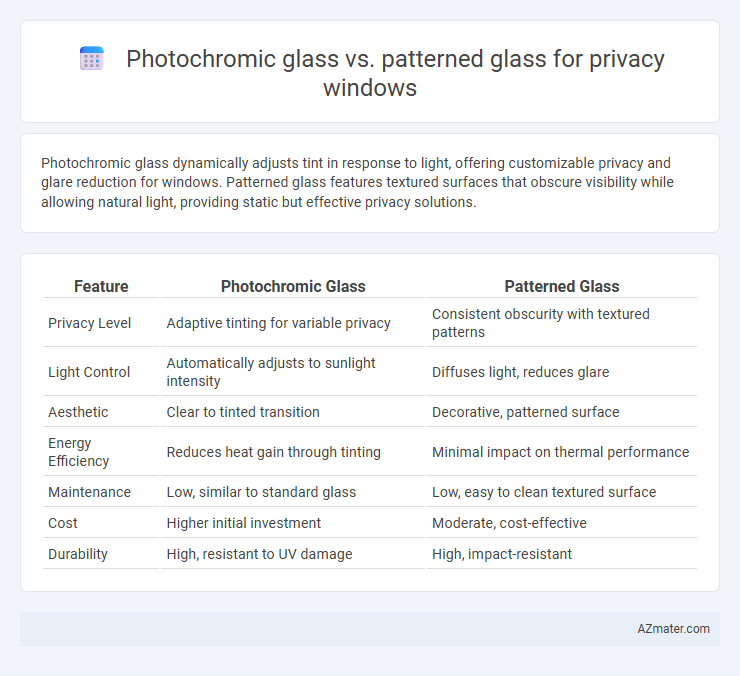Photochromic glass dynamically adjusts tint in response to light, offering customizable privacy and glare reduction for windows. Patterned glass features textured surfaces that obscure visibility while allowing natural light, providing static but effective privacy solutions.
Table of Comparison
| Feature | Photochromic Glass | Patterned Glass |
|---|---|---|
| Privacy Level | Adaptive tinting for variable privacy | Consistent obscurity with textured patterns |
| Light Control | Automatically adjusts to sunlight intensity | Diffuses light, reduces glare |
| Aesthetic | Clear to tinted transition | Decorative, patterned surface |
| Energy Efficiency | Reduces heat gain through tinting | Minimal impact on thermal performance |
| Maintenance | Low, similar to standard glass | Low, easy to clean textured surface |
| Cost | Higher initial investment | Moderate, cost-effective |
| Durability | High, resistant to UV damage | High, impact-resistant |
Introduction to Privacy Windows
Privacy windows utilize materials like photochromic glass, which dynamically adjusts opacity based on light exposure, and patterned glass, designed with textured surfaces to obscure visibility while allowing light transmission. Photochromic glass offers adaptive privacy by darkening in sunlight, ideal for variable privacy needs. Patterned glass provides consistent privacy through various decorative patterns, enhancing aesthetics and maintaining room brightness.
What is Photochromic Glass?
Photochromic glass is a smart glass technology that automatically darkens when exposed to sunlight, offering dynamic privacy and glare reduction without the need for blinds or curtains. This type of glass contains photochromic molecules that react to UV light, adjusting transparency levels in real-time to enhance comfort and energy efficiency. Unlike patterned glass, which relies on fixed decorative textures to obscure visibility, photochromic glass provides adjustable privacy suitable for windows in offices, homes, and commercial spaces.
What is Patterned Glass?
Patterned glass features textured surfaces created by rolling molten glass onto engraved rollers, resulting in various designs that obscure visibility while allowing light transmission, making it ideal for privacy windows. Unlike photochromic glass, which changes tint based on light exposure, patterned glass provides constant privacy without altering transparency levels. Its durability and decorative patterns enhance both functionality and aesthetic appeal in architectural and interior applications.
Advantages of Photochromic Glass for Privacy
Photochromic glass offers dynamic privacy by automatically adjusting its tint in response to sunlight, providing instant shading without the need for blinds or curtains. This smart glass enhances energy efficiency by reducing glare and heat gain while maintaining natural light transmission, unlike patterned glass, which offers static opacity and limited light control. Photochromic glass also supports modern design flexibility, enabling clear views when privacy is not needed, making it ideal for residential and commercial privacy windows.
Benefits of Patterned Glass for Privacy
Patterned glass offers enhanced privacy by obscuring visibility while allowing natural light to filter through, making it ideal for residential and commercial spaces where confidentiality is key. Its textured surface disrupts clear sightlines without sacrificing brightness, creating a balance between privacy and illumination. Unlike photochromic glass, patterned glass maintains consistent privacy regardless of lighting conditions, ensuring reliable screening at all times.
Light Control: Photochromic vs Patterned Glass
Photochromic glass dynamically adjusts its tint based on light exposure, providing adjustable privacy and reducing glare by filtering sunlight as it intensifies. Patterned glass features fixed textures or designs that diffuse light to obscure visibility, offering consistent privacy without altering light transmission. While photochromic glass enables adaptive light control, patterned glass delivers constant light diffusion and privacy regardless of external lighting conditions.
Design Options and Aesthetics
Photochromic glass offers dynamic design options by automatically changing transparency based on light exposure, creating sleek and modern aesthetics with its seamless, clear-to-tinted transition. Patterned glass provides diverse textures and intricate designs, allowing customization through etched or embossed patterns that diffuse light while maintaining privacy. Both materials enhance privacy windows but differ in visual impact: photochromic glass emphasizes functional minimalism, whereas patterned glass highlights decorative versatility.
Energy Efficiency Comparison
Photochromic glass adjusts its tint based on sunlight intensity, reducing heat gain and improving energy efficiency by minimizing cooling loads. Patterned glass provides privacy but lacks dynamic solar control, often resulting in higher reliance on HVAC systems for temperature regulation. Energy savings are typically greater with photochromic glass due to its adaptive light modulation and solar heat reduction capabilities.
Maintenance and Durability
Photochromic glass offers low maintenance due to its ability to automatically adjust to sunlight, reducing the need for frequent cleaning related to dirt buildup and minimizing wear from UV exposure. Patterned glass, while durable and resistant to scratches, may require more regular cleaning to maintain its textured surface and visibility, potentially trapping dust and grime in the patterns. Both types provide durable privacy solutions, but photochromic glass enhances longevity by adapting to environmental conditions, whereas patterned glass relies on its sturdy physical structure for durability.
Cost Analysis and Final Recommendations
Photochromic glass offers dynamic privacy through light-sensitive tinting, typically costing 20-30% more than patterned glass, which features fixed designs for consistent privacy at a lower upfront price. Patterned glass requires less maintenance and no electrical components, making it more cost-effective over time, while photochromic glass may incur higher installation and replacement costs due to its advanced technology. For budget-sensitive projects prioritizing static privacy, patterned glass is recommended; photochromic glass suits high-end applications seeking adaptable privacy with investment in long-term functionality.

Infographic: Photochromic glass vs Patterned glass for Privacy window
 azmater.com
azmater.com